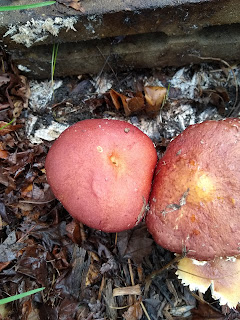Wine cap, or King Strophoria, mushrooms are great companions in your home garden. Depending on the amount of wood chips you have in your pathways, they can get BIG - The Garden Giant!
Easily identifiable wine caps have a red/wine colored caps and a veil that breaks away from the gills and leaves a ring around the stem. The wine color will fade as they age, as will the quality. High in nutrients, low in calories, these delicious mushrooms can be used in a variety of recipes, or are great all on their own sautéed with a little butter.
Enjoy this guest post loaded with information for growing your own mushrooms in the garden by Phoebe Krawczyk at Field & Forest Products
Wine Cap mushrooms are an incredible organism that have the ability to turn cardboard, straw, and/or wood chips into a rich, loamy soil. Wine caps are usually planted as the soil warms up in the spring after the last frost date until several weeks before the first frost date in the Fall of the year.
 |
| First crop in my home garden, you can see the mycelium fibers too |
While the Wine Cap mycelium grows specifically on woody plant material (wood chips, straw, or a mix), the mycelium will reach down into the soil and pull up soil, water and nutrients into the developing mushroom cap, which eventually forms the vehicle for dispersal of Wine Cap progeny... the spore! This is why Wine Caps are anecdotally known as "The Recycler" as Wine Cap mycelium engages in movement of nutrients from soil to surface... a great asset in the garden.
Building a Bed for Smaller Areas:
You can easily build Wine Cap beds in garden areas by creating spaces in partially shaded areas or areas that will have plentiful shade later in that growing space when mushrooms are most likely to flush plentifully, usually August through freeze up time.
 |
| Freshly mulched garden paths with spore along the north edges |
North sides of buildings, Asparagus beds that naturally frond over later in the summer, landscape plantings with trees and shrubs, under fruit trees, under tomatoes, zucchini, blueberry bushes are just some examples of great spots to apply a wood mulch and grow some Wine Cap. You can inoculate several inches of wood chips over soil or over moistened cardboard to help with weed suppression, or into straw beds that are covered with wood chips.
 |
| More Wine Caps! |
Bed maintenance is very low-key, basically keeping the beds from drying out. An important indicator is if the bed is dry at soil level. The top layer of a bed will almost always dry out, but when you plunge your hand into the bed to feel the moisture at soil wood chip interface, it should feel very moist. Your watering regime should aim for maintaining that moist layer- this usually translate to about 1 inch of rainfall or garden sprinkler fall per week.
Your first harvests can come as early as 4 weeks after inoculation, especially if you use straw in the mix. Straw/ Wood chip beds usually last 1 and 1/2 seasons.
Thanks Phoebe!
Now is a great time to plan your gardens, and consider adding Wine caps to your garden paths or beds and tree guilds or food forest understory!
You can purchase Spawn following the link at the sidebar, or off their website here!


